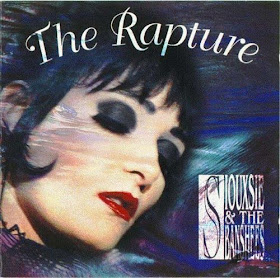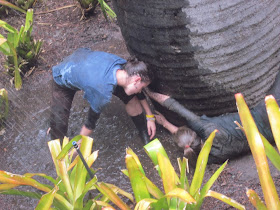Last Saturday, I was able to attend LACMA's ArtWalk festivities. Being a member, the free admission doesn't do much for me, but I do appreciate the opportunity to enjoy some performance art. This year I was able to catch four performances, as well as poke around the galleries.
Now, I'm not well versed in interpretive dance and the techniques of expressive motion. Often times, while looking at a performance, I find myself confused as to the premise of the piece. I'm rarely comfortable determining the choreographer's "meaning" or intent. Therefore, I no longer try. When experiencing performance art, it's all about what the piece means to me.
That being said, here's what I saw:
Skin and Nature
 |
| Audience looks down from above. |
This piece took place at the parking structure elevators, across all three levels. Choreographed by Michel Kouakou, this piece featured performances by the choreographer, Nerissa Castelija, Wilfried Souly, Dorothy Chen, Alexandra Mathews, and Samantha Mohr. The music was Raag Jog and Raag Behaag, works of Indian classical music.
The program notes read:
"In this piece, the dancers explore the ground in contact with their body and mind, trying to create a connection with the earth. The performance is a representation of the mother of all humanity who gives birth to bodies and also receives those bodies in the afterlife."
Alright. I think I get that. Certainly, contact with the ground was an important element to the performance. For instance, there was a part where two of the dancers faced each other, but separated by the window of the elevator. One was on the ground, while the other was enclosed within the elevator.
Was the elevator ascended, the dancers were separated and each began moving with frantic energy. The dancer on the ground moved against the window as though in anguish, while the dancer ascending continued her motions as before.
I think this signifies that the ascending dancer is ignorant of her alienation from the ground, while her partner feels pain at this loss. Alternatively, perhaps the ascending dancer represents Transcendence into the afterlife while the grounded dancer mourns. In any case, the utilization of the three levels of the elevator was well done. Leaving the ground, looking down upon the ground, and moving upon the ground had clear significances.
For instance:
At the base of the palm tree, two dancers move in the "rain" and mud in a manner evocative of both conflict and sex, while two other dancers look on from above. Finally, a third dancer travels in-between levels, climbing from post to post and avoiding the ground. I have no suggestions as to what this signifies, but it is an intriguing arrangement.
Finally, it all ends in the "rain" and mud at the base of the palm tree. I suppose that the palm symbolizes the Mother and the "wetness" is the primordial grounds of creation. The bodies have returned in death to their place of birth. This was a good performance. I really enjoyed Skins and Nature.
Collaborative Improvisation at the Urban Lights
This piece was much more challenging for me. Two rows of colorfully attired performers lined up in opposition at the north and south sections of the Urban Lights sculpture, similar to chessboard pieces. They began a slow back and forth movement along their designated column. (Row = X-Axis, Column = Y-Axis). Then the pace started to pick up and the performers began to occasionally leave their columns and travel in a perpendicular angle along the rows. However, this variation of speed and direction was not universal.
Moreover, sometimes a perform would kneel, sit, or lie down.
At that point, I started wondering if the performance was about the bustle of modern life. Among the dominating structures of Urban Lights, the paths are well defined but lead nowhere. One area of the Lights is more or less the same as any other. The constant drive of moving within this realm of futility is tiring, causing some to pause or even "fall" along the way.
As the movements became more frantic and chaotic, the interactions between the performers grew more dramatic, turning into chases or amiable convergences.
Finally, the performers came together in a positive and affirming group. Once they became a community rather than frantically moving individuals, the performers were free to leave the confine of the Urban Lights, finishing the performance.
I really enjoyed this piece. It was very intellectually stimulating and engaging to watch. The utilization of the performance space was superb. My thanks go out to the performers: Alexandra Shilling, Alison D'Amato, Alissa Cardone, Allison Wyper, Elizabeth Terschuur, Flannery Gregg, Heather Coker, Joe Small, Lisa Wahlander, Maria Gillespie, Nguyen Nguyen, Sara Stranovsky, and Tida Sripanich. Most of these performers seem to be associated with UCLA's Department of World Arts and Culture.
Concentric Circles (After David Smith)
This was a musical performance for three lock-groove lacquers and string trio. This isn't my thing, but I can appreciate it. The lacquers were provide an auditory "ground" upon which the string trio would build harmonic textures. I really wish that I could see it again to fully appreciate the nuances. My first hearing was spent working out the compositional structure so I'm certain that I missed plenty.
There were segments that made me think of Morton Feldman's "
Rothko Chapel" and, at one point, the strings reminded me of George Crumb's "
Black Angels". There was one area where the lacquers became a dominating drone that had a voice-like pulse, sounding like a sentient rotor saying "Shame. Shame. Shame. Shame. Shame."
Again, this really isn't my type of music. And I can't say it was pleasant listening. However, I'm happy that I got to experience it. My thanks to Scott Benzel (composer), Heather Lockie (viola), Cassia Streb (viola), and Jessica Catron (cello).
Matt Witek Quintet
Now, this is my type of music. I finished the evening off with some jazz! I had seen Matt Witek (drums) and Katie Thiroux (bass, vocals) previously. Both are excellent performers. I'm especially fond of Thiroux's cool vocals. Chuck Manning was on tenor sax. Josh Welchez played trumpet. Vicky Nguyen was keyboard.
The performance was only for an hour, with six pieces, but it was a fine hour of good music. After a day of puzzling through conceptual pieces, I was glad to be back on familiar territory. Good stuff!
Here are some links:
UCLA Depratment of World Arts and Cultures
Scott Benzel's
website
Cassia Streb's
website
Matt Witek's
website
Katie Thiroux's
website
Chuck Manning's
website
Josh Welchez's
website
Enjoy!!!

















































